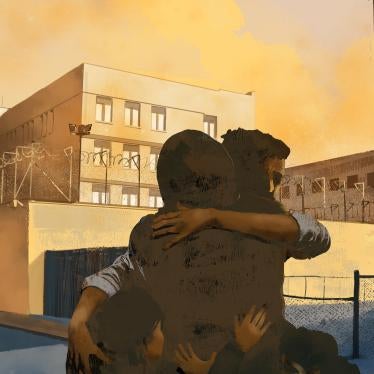The sight of a man, free, who used to be in chains, is breathtaking. And so I gasped as Salim Hamdan walked into the lobby of my hotel in Sana’a, Yemen’s capital, one evening in January. Now in his mid-40s, he looked heavier and happier than I remembered him. In fact, smiling with his wife by his side, he seemed like a different man than the one with whom I had spent countless hours in Guantánamo jail cells preparing for his trial.
It was nearly six years to the day from my first visit to Yemen. Back then, working for the U.S. government as a defense attorney, I had visited over several days with Salim’s family to discuss his case. Salim’s historic trial was still months away, and we had no way of knowing that a mere year later he would be free, or that his case would change the U.S. legal landscape—for a second time. Instead, we talked of his wife’s anguish at not knowing when or even if her husband would ever come home. I met his daughters at the time—one an infant when Salim last saw her; the other born after he was apprehended in Afghanistan, in November 2001. It would be more than seven years before the family would be reunited. But now, as I showed photos of that visit, Salim’s proud wife told me how much the girls had grown, and shared photos of the two sons they have had since he returned.
In an echo of that first visit, I met, earlier that same day, with the family members of men still trapped at the U.S. naval base in Guantánamo Bay, Cuba. Their fathers, sons, husbands, and brothers had already spent over a decade in the prison, but none have been charged with crimes, and many were cleared for release by the U.S. government years ago. Compared with them, Hamdan is the “lucky” one. The stories of their pain and bewilderment at their loved ones’ predicament became oppressive at times. Feeling dizzy with jet lag and the high altitude—Sana’a is 7,300 feet above sea level—I struggled to keep the men’s stories from blurring together in my mind. Seeing Salim again brought them all into sharp focus. Each man I had heard about that day was a man like him, with a family desperate for news of their relative’s fate.
Some call it “the Yemen problem,” and it’s the main reason the detention center at Guantánamo Bay remains open, despite repeated pledges by President Obama—since the very start of his presidency—to close it. Of the 155 detainees who remain there, more than half are Yemeni. While the Obama administration plans to continue to hold some detainees indefinitely, it has determined that 56 of these Yemenis pose so little threat to U.S. national security that they can be released. These are men apprehended in the early days of the so-called war on terror, swept up in Afghanistan or Pakistan. Whether captured on the battlefield or kidnapped and sold for ransom, many lost touch with their families for months or even years.
Why are they still stuck at Guantánamo? Whatever they may or may not have done, these are men the U.S. never intends to charge with a crime. President Obama announced last May that he had lifted a self-imposed ban on detainee transfers from Guantánamo to Yemen. Yet in Guantánamo they remain. The Yemenis are being held indefinitely for many reasons, not the least of which is that they are from Yemen. To some U.S. policymakers, this sounds reasonable. Yemen is dangerous, they say. The Obama administration has identified the Yemen-based al-Qaida in the Arabian Peninsula, or AQAP, as the most active of al-Qaida’s/the group’s affiliates.
Just last month AQAP staged a prison break of terrorist suspects in Sana’a. But the Yemenis in Guantánamo are destined for release, not prison. Some were hours away from going home when Obama imposed a moratorium on transfers to Yemen, not because of anything those men had done, but because the so-called underwear bomber—a Nigerian who tried to bomb a Detroit-bound airliner on Dec. 25, 2009 —had received training in Yemen. The Obama administration fears that anyone sent back to Yemen would swiftly be recruited by terrorists.
In some ways, Salim really was lucky. As one of the first detainees to be tried in the Bush administration’s fundamentally flawed military commissions system, he at least had the opportunity to defend himself. And although he was found guilty in 2008, his conviction was overturned in 2012 by an appellate court, which ruled that the military commissions lacked jurisdiction to try the crime of which he was accused—providing material support for terrorism. Only a handful of the detainees still waiting at Guantánamo will ever be tried. The rest remain in limbo, many waiting for a promised release that never comes. Frustration drove more than 100 detainees to go on hunger strike last spring and summer. Since then, fewer than a dozen prisoners have been released, none of them Yemeni.
The families I met with in Sana’a told me about receiving letters from the International Committee of the Red Cross, informing them that their family member was in Guantánamo. They then communicated for years via heavily redacted letters. A few years ago, the International Committee of the Red Cross implemented a system of video calls. The calls have been a mixed blessing. Mothers told me of the pain they feel seeing their sons on a screen, unable to reach out and touch them, their conversations reduced to a short greeting by each member of the extended family. And last year, with so many on hunger strike, the video calls allowed these same families to see the men’s bodies deteriorating. Though the number of detainees refusing to eat has dropped into the low 30s, the hunger strike continues.
There is a glimmer of hope for the Yemeni detainees. The government in Sana’a has announced it is developing—with United Nations assistance—a “rehabilitation” program for repatriating Yemeni detainees. But it could take years to get it up and running, and it is not yet clear whether the program will offer true reintegration for these men or simply continue unlawful detention elsewhere. In the meantime, the prisoners and their families wait.
If the large Yemeni population at Guantánamo is not allowed to leave, Guantánamo will never close. As I said goodbye and watched Salim and his wife leave so they could go home to their children, I wondered how many other families would be reunited one day. Unless the U.S. follows through with its commitment to restart transfers to Yemen, the answer will be: very few.






